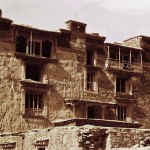View of Chinese vernacular dwelling-2
Cave-style dwelling has explicitly regional characteristics in the natural ecology, remaining the most primitive architectural features among all vernacular dwelling patterns.
The drought area in the Loess plateau in the northwest China is the area where the kind of dwellings most centralized. The most typical cave-style dwelling is the Cave Dwelling which can be largely found in the middle and west regions including Henan, Shanxi, Shaanxi and Gansu, including the “underground Cave Dwelling” in the west of Henan and plains of southern Shaanxi – a kind of Cave Dwelling wholly 7 built under the ground. Caves are dug with earth steps as entrance. This kind of dwelling is inhabited by several or a dozen of households and is still completely kept in Liquan County of Xi’an (Shaanxi Province);
The “cliff-along” Cave Dwelling – another kind of Cave Dwelling widely adopted in mountainous regions and usually converged transversely and multiply along the contour line with connecting caves dug on natural hillsides and a courtyard can be built with adobe outside the cave; “plugging Cave Dwelling” – a mixed form mostly appear in the middle of Shanxi with one or two storied arched adobe or brick house outside the cave and form a courtyard with walls, which seems more flexible in settlement combination and richer in inner space.
And, there is a kind of semi-underground-cave dwelling remained in the settlements of Taiya and Yamei nationalities in Taiwan Province. Its shape is quite natural: generally with a rectangular flat covered with cobblestones and caved in about 1.5m, woodframework upper structure using bamboo as purlin and being covered by day lily as roof. The whole settlement scattered loosely, which is believed to form in the long time of encountering typhoon, earthquake and other frequent disasters and remains till now.
Despite of its limited space, there still has reserved the place for sacrifices in  this kind of dwelling. The Cave Dwelling, clay dwelling, or even the vernacular dwelling made of uncalcined clay, rammed earth, scattered in the drought or desert areas, such as Zhuangguo in the east of Qinghai Province, watchtower of Tibetan nationality in the areas of Sichuan, Qinghai and Tibet and even Gaotai vernacular dwelling in Kashi of the Xinjiang Uygur Autonomous Region, all belong to the category of uncalcined clay dwelling.
this kind of dwelling. The Cave Dwelling, clay dwelling, or even the vernacular dwelling made of uncalcined clay, rammed earth, scattered in the drought or desert areas, such as Zhuangguo in the east of Qinghai Province, watchtower of Tibetan nationality in the areas of Sichuan, Qinghai and Tibet and even Gaotai vernacular dwelling in Kashi of the Xinjiang Uygur Autonomous Region, all belong to the category of uncalcined clay dwelling.